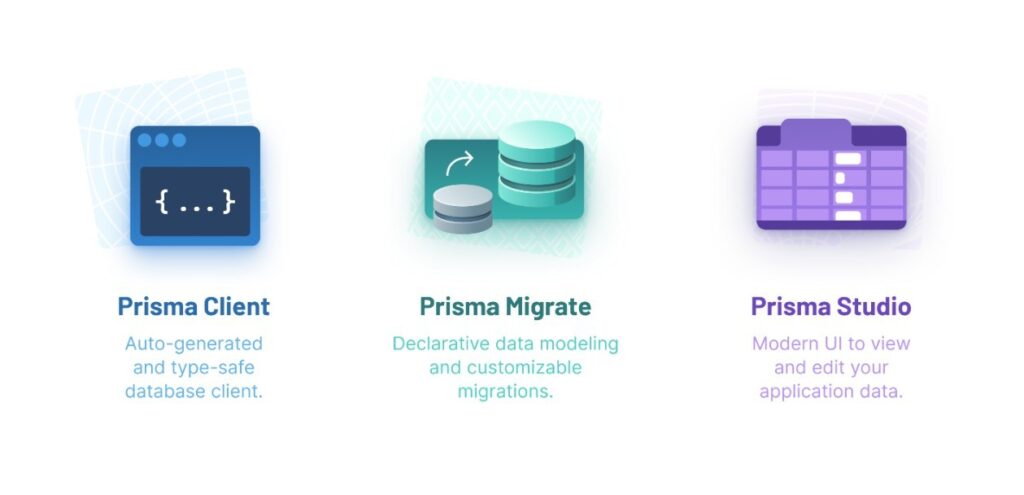Prisma is a powerful ORM (Object-Relational Mapping) tool that simplifies database operations in Node.js applications. It provides type safety, auto-completion, and clear APIs to interact with various databases. Here’s a simple guide to get you started with Prisma in a Node.js application.
Table of Contents
Key Features of Prisma

1. Type Safety
One of Prisma’s standout features is its strong focus on type safety. Using Prisma with TypeScript guarantees that any database queries you write are validated at compile time, helping you catch errors early in the development process. This is particularly valuable when working with large codebases, as it reduces the likelihood of runtime errors related to incorrect data types or missing fields.
2. Intuitive Data Modeling
Prisma uses a schema definition language (Prisma Schema Language) that allows developers to define their database models in a readable and organized manner. The schema is maintained in a single file, making it easy to manage and update as your application evolves. Once you define your data model, Prisma’s generator creates a client API, which you can use to perform database operations seamlessly.
3. Migrations Made Easy
Database migrations are often a headache for developers, especially in collaborative environments. Prisma simplifies the migration process, allowing you to keep track of schema changes and automatically generate migration scripts. This feature not only ensures consistency across different environments but also makes it easy to roll back changes if something goes wrong.
4. Declarative Querying
Prisma provides a powerful query API that allows developers to write complex queries without dealing with raw SQL. This API is designed to be intuitive and easy to use, enabling you to focus on your application’s logic rather than the underlying database intricacies. With Prisma’s query API, you can effortlessly perform filtering, sorting, pagination, and more.
5. Multi-Database Support
Prisma supports a wide range of databases, including PostgreSQL, MySQL, SQLite, and SQL Server, among others. This flexibility allows developers to choose the database that best suits their application’s needs, ensuring that they can adapt their technology stack as requirements evolve.
Benefits of Using Prisma ORM
Increased Developer Productivity
Prisma significantly cuts down the amount of boilerplate code needed to interact with databases. As a result, developers can focus on writing business logic rather than repetitive database code, leading to faster development cycles and increased productivity.
Enhanced Collaboration
By using Prisma’s clear schema definition and migration management features, teams can collaborate more effectively. Developers can easily see the structure of the database and understand the relationships between different models, reducing the chances of miscommunication regarding data handling.
Seamless Integration
Prisma is designed to work well with modern application frameworks such as Next.js, GraphQL, and REST APIs. This seamless integration allows developers to build robust, data-driven applications without worrying about compatibility issues.
Community and Ecosystem
Prisma has a thriving community that contributes to its ongoing development and improvement. This strong ecosystem means that developers have access to a wealth of resources, including documentation, tutorials, and community support, making it easier to adopt and implement.
1. Setting Up a Node.js Project
First, you need to set up a Node.js project if you haven’t already. You can do this by creating a new directory and initializing a new Node.js project.
mkdir prisma-example
cd prisma-example
npm init -y2. Installing Prisma ORM
You’ll need to install the Prisma CLI and the Prisma client:
npm install @prisma/client
npm install prisma --save-devstep-by-step-guide-to-create-a-model-file-in-prisma3. Initializing Prisma ORM
To initialize Prisma in your project, run the following command. This will create a prisma folder with a schema.prisma file.
npx prisma init4. Configuring the Database
Open the prisma/schema.prisma file. Configure your database connection URL in the datasource block. For example, if you are using PostgreSQL, it would look something like this:
datasource db {
provider = "postgresql"
url = env("DATABASE_URL")
}
generator client {
provider = "prisma-client-js"
}Set the DATABASE_URL in your .env file:
DATABASE_URL="postgresql://user:password@localhost:5432/mydb"5. Defining Your Data Model
In the same schema.prisma file, define your data models. For example, if you want to create a simple User model:
model User {
id Int @id @default(autoincrement())
name String
email String @unique
}6. Running Migrations
To create the database tables based on your models, run the following commands:
npx prisma migrate dev --name initThis command will create a new migration for the changes made to the schema and apply them to the database.
7. Generate Prisma Client
After defining your models and running migrations, generate the Prisma Client using:
npx prisma generate8. Using Prisma in Your Application
Now you can use Prisma ORM in your application. Create a file called index.js and use Prisma client to perform database operations:
const { PrismaClient } = require('@prisma/client');
const prisma = new PrismaClient();
async function main() {
// Create a new user
const newUser = await prisma.user.create({
data: {
name: 'Alice',
email: 'alice@example.com',
},
});
console.log('Created new user:', newUser);
// Fetch all users
const allUsers = await prisma.user.findMany();
console.log('All users:', allUsers);
}
// Execute the main function
main()
.catch(e => {
throw e;
})
.finally(async () => {
await prisma.$disconnect();
});9. Running Your Application
You can run your Prisma ORM application using:
node index.jsAdditional Commands
- To reset the database and apply migrations again:
npx prisma migrate reset- To view the generated database schema:
npx prisma studioConclusion
This is a basic introduction to using Prisma with Node.js. Prisma can do much more, like querying related data, pagination, and advanced filtering. Be sure to check the Prisma Documentation for more features and detailed guides.
Understanding DevOps: Bridging the Gap Between Development and Operations




[…] Enhance Node.js Apps with Prisma ORM for Database Ease […]